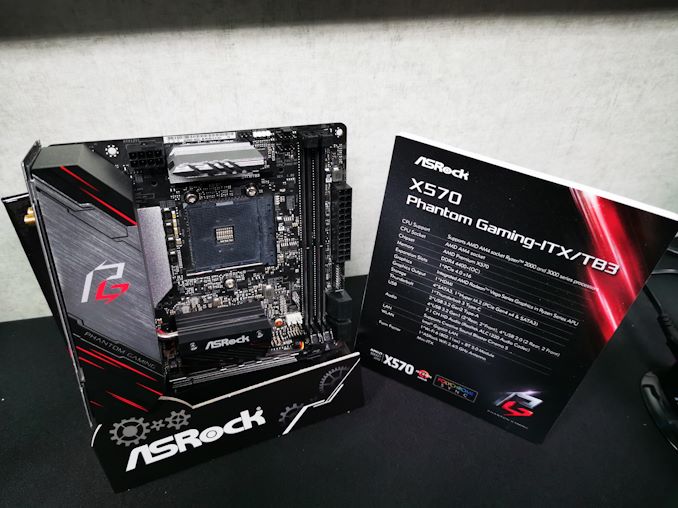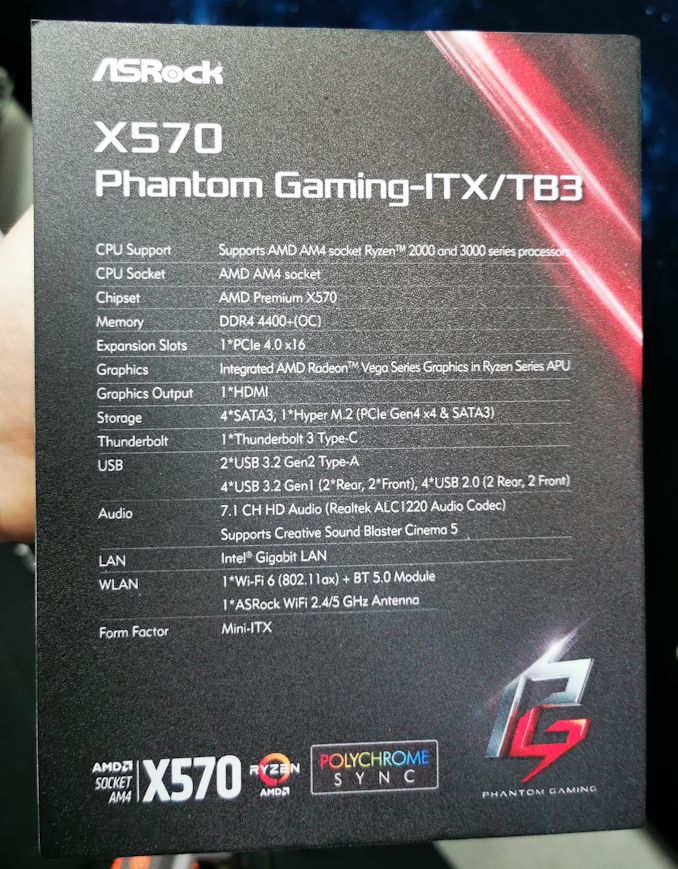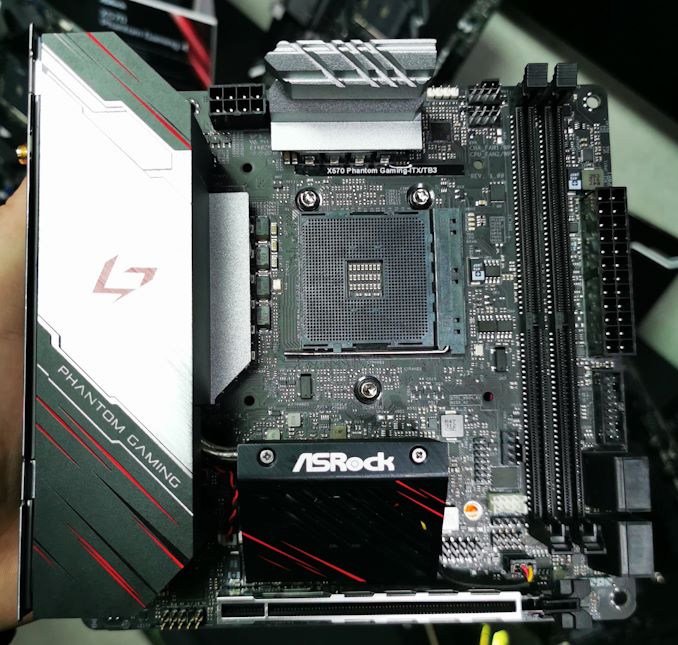ASRock X570 Phantom Gaming-ITX TB3: The Small Motherboard with a Side of Everything
by Gavin Bonshor on June 18, 2019 4:00 PM EST
During Computex 2019, ASRock announced its upcoming X570 range ready for the launch of AMD's Ryzen 3000 series processors. One of the motherboard highlights of the show was the ASRock X570 Phantom Gaming-ITX TB3, which includes a very solid feature set including Thunderbolt 3 Type-C, a solid looking 10-phase power delivery, and a Wi-Fi 6 802.11ax wireless interface.
The ASRock X570 Phantom Gaming-ITX TB3 joins a small handful of small form factor X570 models at launch but looks to stand-out from the crowd with a major feature; a Thunderbolt 3 Type-C connector on the rear panel. Following in line with the rest of its premium X570 product stack, ASRock has equipped the board with a hefty looking 10-phase power delivery, and official support for DDR4-4400 memory across two available slots. A single full-length PCIe 4.0 x16 slot is located at the bottom of the board, with a single PCIe 4.0 x4 M.2 slot, and just four SATA ports. The networking is handled by an Intel Gigabit port, while the Wi-Fi 6 802.11ax wireless interface is controlled by the Killer AX1650 interface with support for BT 5 devices.
On the rear panel alongside the single Thunderbolt 3 Type-C connector which is the highlight of the board, the ASRock X570 Phantom Gaming-ITX TB3 also includes a single USB 3.1 G2 Type-A, a single USB 3.1 G2 Type-C, and two USB 3.1 G1 Type-A ports. On the display model at Computex, there is a clear CMOS button, a DisplayPort input and HDMI video output, with a PS/2 combo port, and five 3.5 mm color coded audio jacks with a S/PDIF optical output due to the use of a Realtek ALC1220 HD audio codec.

The specifications listed at Computex differ from what's actually featured physically on the rear panel. ASRock told us there were last minute changes.
The availability and pricing of the ASRock X570 Phantom Gaming-ITX TB3 mini-ITX motherboard are currently unknown, but we expect it to launch with the rest of ASRock's announced X570 models on 7/7.
| Want to keep up to date with all of our Computex 2019 Coverage? | ||||||
 Laptops |
 Hardware |
 Chips |
||||
| Follow AnandTech's breaking news here! | ||||||












37 Comments
View All Comments
ingwe - Wednesday, June 19, 2019 - link
Thanks for these awesome explanations! It is one of the reasons that I keep coming here.bhtooefr - Thursday, June 20, 2019 - link
Note that there are standardized ways to send things back *if you have an IGP*, by sending raw video data (not DisplayPort packets) over PCIe.Nvidia Optimus and AMD Switchable Graphics both support a mode in which the PCI-E GPU uses DMA to put the video content into the IGP's framebuffer, and then the IGP handles getting it to the display. This is the cheaper way to implement graphics switching (the more expensive way involves muxes that actually switch the outputs between the two GPUs), and it's also how Thunderbolt external GPU boxes work. (And, it's how the hack that someone discovered to get VESA Adaptive Sync working on a Nvidia GPU, involving slapping a second AMD GPU in and connecting your monitors to it, before Nvidia did the whole "G-Sync Compatible" thing, worked.)
But, all of that needs an IGP to work.
HStewart - Tuesday, June 18, 2019 - link
Any news on what is driving the Thunderbolt 3 on this system. It actually good news to see Thunderbolt 3 on non Intel systems. It probably become more important since it part of USB4 standard.SaturnusDK - Wednesday, June 19, 2019 - link
Probably a JHL6540 like most Intel MBs (mobile or otherwise) with a single TB3 port.SaturnusDK - Wednesday, June 19, 2019 - link
I meant JHL6340 obviously. The JHL6540 is the double port version.danielfranklin - Wednesday, June 19, 2019 - link
Agreed, i was starting to think there was a limitation or something.5080 - Tuesday, June 18, 2019 - link
Also the B550 won't offer PCIe 4.0 for graphics cards, only for M.2 storage options. So I think the 570 has a place for ITX boards if you want to run it with a PCIe 4.0 GPU.wilsonkf - Tuesday, June 18, 2019 - link
Even current motherboard can provide PCIe "3.5" performance. Even using old chipset new motherboard should be able to reach a PCIe bandwidth close to PCIe 4.KateH - Tuesday, June 18, 2019 - link
how is that possible? Either it's using PCIe 3.0 signaling which is intrinsically limited to PCIe 3.0 speeds, or it's using PCIe 4.0 signaling which intrinsically allows PCIe 4.0 speeds. There's no such thing as PCIe 3.5 and that kind of data bus isn't something that can be "overclocked" because any deviation from the standards on the part of mobo manufacturers would break compatibility with add-in cards.TheUnhandledException - Tuesday, June 18, 2019 - link
There is no such thing. It is PCIe 3 or it is PCIe 4. The card, host, and interface run a set speed they don't just randomly pick a speed somewhere between the two standards. Now PCIe is both forwards and backwards compatible but everything runs at the lowest common denominator. 3.0 card in a 4.0 slot = 3.0 speed. 4.0 card in a 3.0 slot = 3.0 speed.